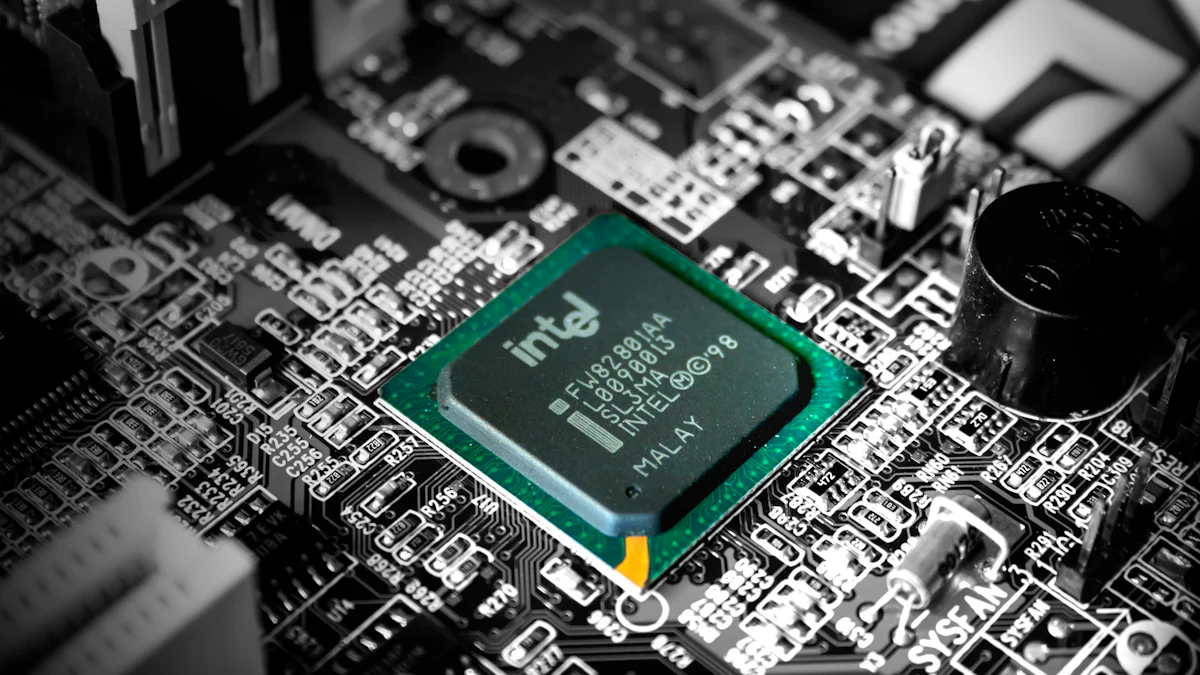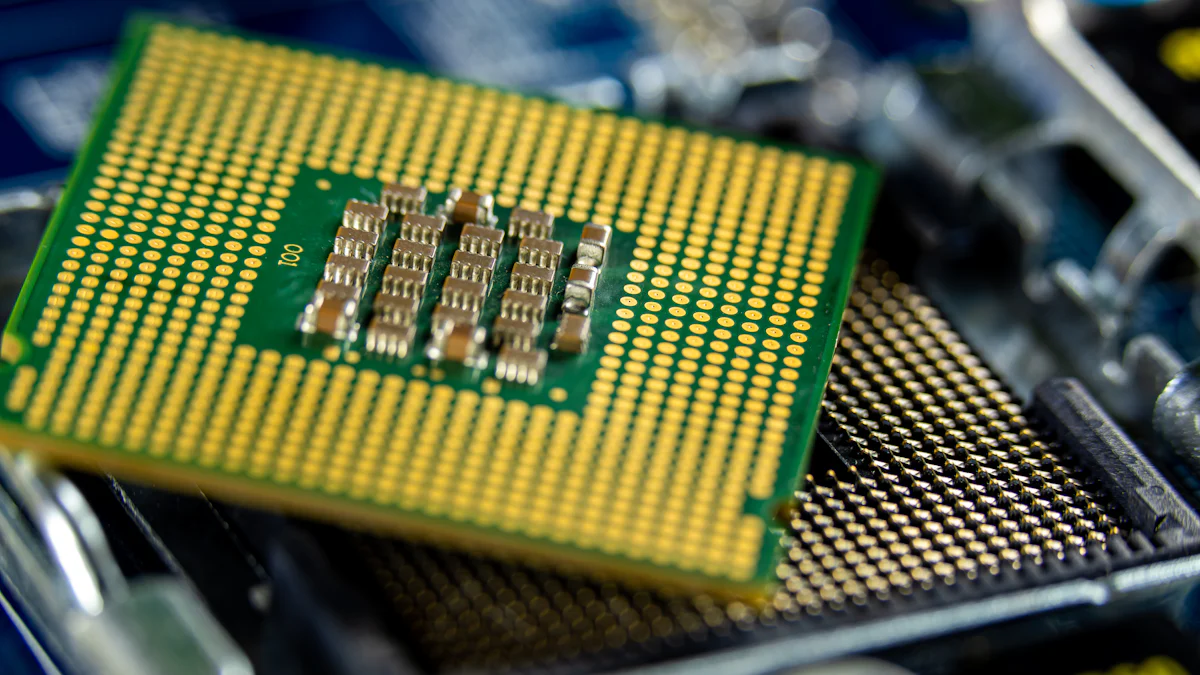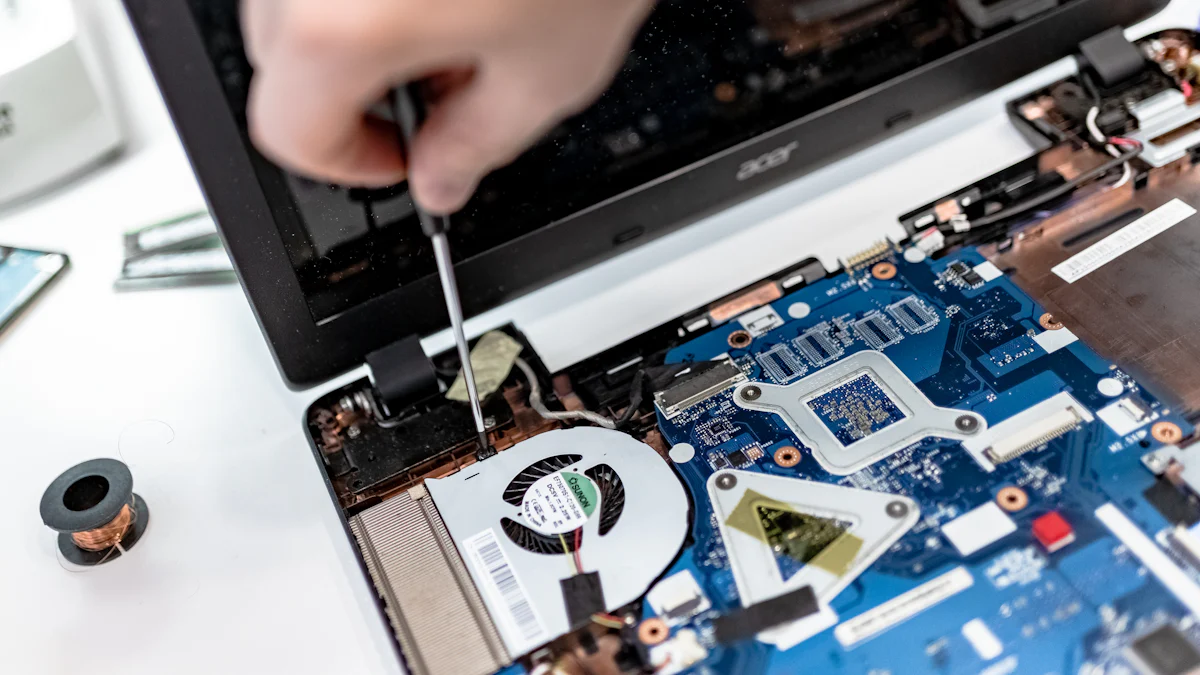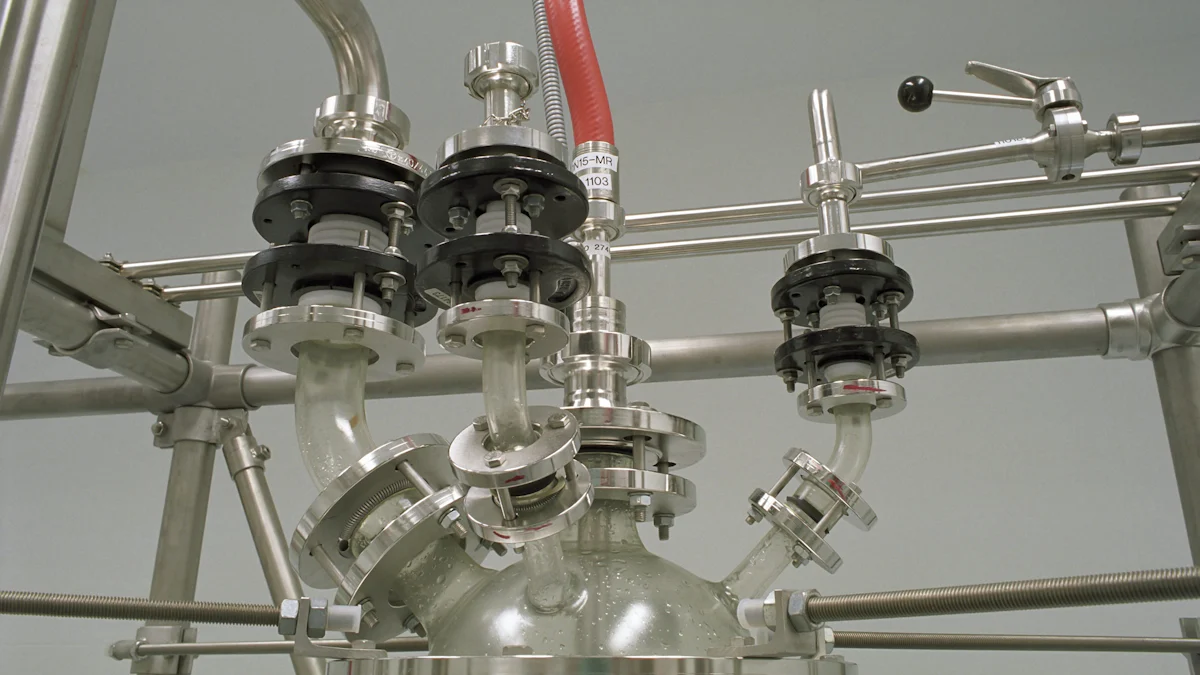Aixtron reactor components revolutionize material deposition processes with their advanced designs. The Close Coupled Showerhead (CCS) system ensures uniform thin film deposition, a critical requirement for industries like semiconductors and optoelectronics. The Planetary Reactor® enhances scalability and precision, enabling consistent performance across production cycles. These technologies support nanoscale material deposition, fostering breakthroughs in nanostructure fabrication and quantum computing. As a global leader, Aixtron provides the most widely used tools for large-scale semiconductor production, redefining expectations in efficiency and versatility.
Key Takeaways
- Aixtron's Close Coupled Showerhead (CCS) design ensures uniform thin film deposition, crucial for high-quality semiconductor and optoelectronic applications.
- The Planetary Reactor® combines scalability and efficiency, enabling mass production without sacrificing quality, making it ideal for high-throughput environments.
- Aixtron reactor components support advanced material deposition, driving innovation in fields like quantum computing and renewable energy technologies.
- By simplifying operational complexity, the CCS design allows manufacturers to achieve high-quality deposition while handling complex materials like gallium oxide.
- Aixtron's commitment to continuous innovation ensures that their reactors remain at the forefront of technology, enhancing capabilities and efficiency across industries.
- These advanced reactors challenge the belief that high-quality systems cannot scale, proving that efficiency and precision can coexist in modern manufacturing.
Overview of Aixtron Reactor Components
Key Components of Aixtron Reactors
Close Coupled Showerhead (CCS) Design: Ensuring uniform thin film deposition
The Close Coupled Showerhead (CCS) design represents a breakthrough in material deposition technology. This innovative system ensures precise and uniform thin film deposition, a critical factor for industries such as semiconductors and optoelectronics. By integrating advanced features like in-situ multichannel pyrometers and adjustable gap settings, the CCS design optimizes deposition processes across a wide pressure range. Its ability to handle complex materials, including gallium oxide for power devices, highlights its versatility and reliability.
Manufacturers benefit from the CCS system's ability to maintain high-quality deposition while simplifying operational complexity. For instance, its application in OLED manufacturing and polymer-based electronics demonstrates its adaptability to diverse production needs. The CCS design continues to set new standards in achieving uniformity and accuracy, making it an indispensable component in modern semiconductor production.
Planetary Reactor®: Optimized for mass production of semiconductor components
The Planetary Reactor® is engineered to meet the demands of mass production in semiconductor manufacturing. Its user-friendly operation, combined with excellent process stability, ensures consistent performance even in high-throughput environments. This reactor excels in achieving high precursor efficiency and uniformity, which are essential for producing compound semiconductors used in LEDs, transistors, and other advanced devices.
AIXTRON's AIX G5+ technology package, built on the Planetary Reactor® platform, exemplifies its commitment to innovation. This system supports GaN-on-Si (Gallium Nitride on Silicon) technology, enabling manufacturers to achieve superior device yields. The Planetary Reactor® not only enhances scalability but also ensures reliability, making it a cornerstone for industries requiring precision and efficiency in large-scale production.
General Purpose of Aixtron Reactor Components
Supporting advanced material deposition for high-performance applications
Aixtron reactor components play a pivotal role in supporting advanced material deposition processes. These components enable the production of high-performance applications, including power devices, optoelectronics, and quantum computing technologies. By ensuring uniformity and precision, they allow manufacturers to push the boundaries of innovation. For example, the CCS system has been instrumental in cutting-edge research, such as the development of gallium oxide power devices, showcasing its ability to handle complex materials with ease.
Enabling cutting-edge semiconductor manufacturing with scalability and efficiency
Scalability and efficiency are at the core of Aixtron reactor components. The Planetary Reactor® exemplifies this by offering high throughput without compromising on quality. Its advanced features, such as excellent process stability and high uptime, ensure that manufacturers can meet growing demands while maintaining cost-effectiveness. These components empower industries to scale their operations seamlessly, supporting the development of next-generation technologies like quantum processors and ultra-high-brightness LEDs.
Common Beliefs About Reactor Components
Traditional Expectations in Reactor Design
Uniformity in material deposition is difficult to achieve
For decades, achieving uniformity in material deposition has been considered a significant challenge in reactor design. Traditional systems often struggled to maintain consistent thin film layers across substrates, especially when processing complex materials. Engineers frequently encountered issues such as uneven distribution of precursors and temperature variations within the reactor chamber. These inconsistencies led to defects in the final product, reducing overall efficiency and reliability.
The belief that uniform deposition is inherently difficult stems from the limitations of early reactor technologies. For example, early nuclear reactors, like the Chicago Pile-1 in 1942, demonstrated the potential of controlled reactions but lacked the precision required for advanced material processing. While these systems laid the foundation for modern reactors, they highlighted the technical hurdles in achieving uniformity. This perception persists, influencing how industries approach reactor design today.
Scalability and efficiency are limited in high-quality systems
Another common belief is that high-quality reactor systems cannot achieve scalability and efficiency simultaneously. Many assume that increasing production capacity compromises the precision and performance of the system. This notion arises from the historical trade-offs observed in manufacturing processes, where scaling up often led to inefficiencies or reduced product quality.
In the context of energy production, nuclear reactors provide a relevant example. The 441 operational nuclear power reactors worldwide supply approximately 15% of global electricity. Despite their contribution to carbon-free energy, these reactors face criticism for their scalability challenges. Expanding nuclear energy infrastructure requires significant investment and time, reinforcing the idea that high-quality systems struggle with scalability. This belief extends to material deposition technologies, where manufacturers often prioritize either quality or efficiency, rarely achieving both.
Assumptions About Performance and Innovation
High costs are a barrier to innovation in reactor technology
The perception that innovation in reactor technology comes at a high cost remains widespread. Developing advanced systems often involves substantial research and development expenses, deterring smaller companies from pursuing innovation. This assumption creates a barrier to entry, limiting competition and slowing technological progress.
Historically, the nuclear energy sector illustrates this challenge. The severe accidents at Three Mile Island (1979), Chernobyl (1986), and Fukushima (2011) prompted stricter safety regulations, increasing the cost of reactor development. These incidents shaped public opinion, associating advanced reactor technologies with high financial and operational risks. Similar concerns influence the semiconductor industry, where the cost of developing cutting-edge reactors often outweighs the perceived benefits.
Existing technologies are sufficient for current material processing needs
Many industries operate under the assumption that existing technologies adequately meet their material processing requirements. This belief discourages investment in new reactor designs, as manufacturers prioritize short-term cost savings over long-term innovation. However, relying on outdated systems limits the potential for breakthroughs in fields like quantum computing and renewable energy.
The reliance on existing technologies mirrors the early days of nuclear energy. While early reactors like Chicago Pile-1 demonstrated the feasibility of nuclear power, they lacked the efficiency and scalability needed for widespread adoption. Over time, advancements in reactor design addressed these limitations, proving that innovation drives progress. Similarly, modern industries must recognize the limitations of current material deposition technologies and embrace new solutions to stay competitive.
How Aixtron Components Defy These Beliefs

Unique Features of Aixtron Reactor Components
Close Coupled Showerhead (CCS) Design: Challenges assumptions by achieving high-quality deposition with simplicity
The Close Coupled Showerhead (CCS) design redefines the standards of thin film deposition. Unlike traditional systems, which often struggle with uniformity, the CCS design ensures precise material distribution across substrates. This innovation simplifies the deposition process while maintaining exceptional quality. By integrating advanced features like adjustable gap settings and in-situ monitoring tools, the CCS system achieves unparalleled control over deposition parameters.
This design also addresses the challenges of handling complex materials. For instance, it supports the deposition of gallium oxide, a material critical for power devices. The CCS design proves that achieving high-quality deposition does not require overly complex systems. Its simplicity and efficiency make it a preferred choice for industries aiming to enhance precision without compromising operational ease.
Planetary Reactor®: Demonstrates scalability and efficiency in mass production
The Planetary Reactor® exemplifies how scalability and efficiency can coexist in semiconductor manufacturing. This reactor achieves high throughput while maintaining uniformity and reliability, addressing the common belief that scaling up compromises quality. Its user-friendly operation and excellent process stability ensure consistent performance, even in demanding production environments.
AIXTRON's Planetary Reactor® platform supports advanced technologies like GaN-on-Si (Gallium Nitride on Silicon), enabling manufacturers to produce high-performance devices at scale. The reactor's high precursor efficiency and uptime further enhance its value, making it a cornerstone for industries requiring large-scale production. By combining scalability with precision, the Planetary Reactor® challenges traditional assumptions about manufacturing limitations.
Examples of Aixtron's Breakthroughs
AIXTRON 3x2” CCS-type MOVPE reactor: Versatility in handling diverse materials
The AIXTRON 3x2” CCS-type MOVPE reactor showcases the versatility of Aixtron reactor components. This system effectively handles a wide range of materials, including those considered difficult to process. Its ability to adapt to various deposition requirements makes it a valuable tool for industries exploring new materials and applications.
This reactor also supports the development of next-generation technologies. For example, its role in producing high-quality compound semiconductors highlights its adaptability and precision. By offering a flexible solution for diverse material processing needs, the AIXTRON 3x2” CCS-type MOVPE reactor sets a new benchmark for versatility in the industry.
Advanced MOCVD reactors: Continuous innovation to enhance capabilities and efficiency
AIXTRON's advanced MOCVD reactors represent the company's commitment to innovation. These reactors incorporate cutting-edge features to improve efficiency and expand their capabilities. For instance, they support the production of energy-efficient LEDs and laser technologies, contributing to advancements in renewable energy and optoelectronics.
The continuous evolution of MOCVD reactors demonstrates AIXTRON's dedication to addressing industry challenges. By enhancing process stability and reducing operational costs, these reactors enable manufacturers to achieve higher yields and better performance. This ongoing innovation ensures that AIXTRON remains at the forefront of reactor technology, driving progress across multiple sectors.
Real-World Applications and Impacts

Applications in Semiconductor Manufacturing
Enhancing efficiency in chip production with precise material deposition
Aixtron reactor components play a pivotal role in advancing semiconductor manufacturing. Their precision engineering ensures uniform material deposition, a critical factor in chip production. The Close Coupled Showerhead (CCS) design, for instance, achieves consistent thin film layers across substrates, reducing defects and enhancing wafer yields. This level of precision minimizes variability, enabling manufacturers to meet stringent quality standards in high-volume production environments.
The Planetary Reactor® further optimizes chip production by delivering high throughput without compromising quality. Its advanced features, such as excellent process stability and high precursor efficiency, streamline manufacturing processes. By leveraging these technologies, semiconductor companies can produce chips with greater efficiency, supporting the growing demand for high-performance devices in industries like consumer electronics and telecommunications.
Expert Testimony:
"AIXTRON reactor components ensure consistent performance by leveraging advanced technologies such as the Planetary Reactor. This innovative system delivers uniform material deposition across production cycles, a critical factor in industries like semiconductors and optoelectronics."
Supporting the development of next-generation devices like quantum processors
The precision and scalability of Aixtron reactor components also drive innovation in next-generation technologies. Quantum processors, which require nanoscale material deposition, benefit significantly from the uniformity and reliability offered by these systems. The CCS design, known for its ability to handle complex materials like gallium oxide, supports the development of quantum computing components with exceptional performance.
By enabling the production of high-quality semiconductors, Aixtron reactors contribute to breakthroughs in quantum technology. These advancements pave the way for faster data processing, enhanced encryption methods, and revolutionary applications in fields such as artificial intelligence and scientific research. Aixtron's commitment to innovation ensures that its reactor components remain at the forefront of supporting cutting-edge technologies.
Broader Implications for Industries
Accelerating innovation in renewable energy through advanced material processing
Aixtron reactor components significantly impact the renewable energy sector by enabling advanced material processing. Their ability to deposit thin films with precision supports the production of energy-efficient devices such as LEDs and solar cells. The Planetary Reactor®, for example, enhances scalability, allowing manufacturers to produce these components in large volumes while maintaining high quality.
This scalability accelerates the adoption of renewable energy technologies, reducing reliance on fossil fuels. By improving the efficiency and affordability of devices like solar panels, Aixtron reactors contribute to global efforts to combat climate change. Their role in advancing material processing underscores their importance in driving innovation across the renewable energy industry.
Enabling advancements in quantum computing with high-quality components
Quantum computing relies on high-quality components to achieve its full potential. Aixtron reactor components, with their precision and adaptability, provide the foundation for these advancements. The AIXTRON 3x2” CCS-type MOVPE reactor, for instance, demonstrates versatility in handling diverse materials, making it ideal for producing quantum computing components.
By supporting the development of quantum processors and other advanced devices, Aixtron reactors enable industries to explore new possibilities. These innovations have far-reaching implications, from revolutionizing data security to solving complex scientific problems. Aixtron's dedication to enhancing reactor technology ensures that it continues to play a vital role in shaping the future of quantum computing.
Aixtron reactor components redefine industry standards by combining precision engineering with innovative designs. These advancements challenge traditional assumptions, proving that high-quality deposition can coexist with scalability and adaptability. By driving progress in semiconductor manufacturing, renewable energy, and quantum computing, Aixtron continues to lead the way in technological innovation. Its reactors, with a proven track record spanning nearly three decades, remain indispensable tools for industries seeking efficiency and performance. As Aixtron advances MOCVD technology, it accelerates the adoption of GaN devices, contributing to a more sustainable future and setting new benchmarks for reactor technology.
FAQ
What makes Aixtron reactor components unique?
Aixtron reactor components stand out due to their innovative designs, such as the Close Coupled Showerhead (CCS) system and the Planetary Reactor®. These technologies ensure uniform thin film deposition, high scalability, and exceptional efficiency. Their ability to handle complex materials like gallium oxide further highlights their versatility and reliability in advanced material processing.
How does the Close Coupled Showerhead (CCS) design improve thin film deposition?
The CCS design optimizes thin film deposition by ensuring precise material distribution across substrates. It incorporates advanced features like adjustable gap settings and in-situ monitoring tools, which enhance control over deposition parameters. This design achieves uniformity and accuracy, even when processing challenging materials, making it ideal for high-performance applications.
Why is the Planetary Reactor® suitable for mass production?
The Planetary Reactor® excels in mass production due to its high throughput, process stability, and user-friendly operation. It maintains uniformity and reliability across production cycles, ensuring consistent quality. Its advanced features, such as high precursor efficiency, make it a preferred choice for industries requiring large-scale semiconductor manufacturing.
Can Aixtron reactors handle diverse materials?
Yes, Aixtron reactors effectively process a wide range of materials, including those considered difficult to handle. For example, the AIXTRON 3x2” CCS-type MOVPE reactor demonstrates versatility by supporting the deposition of materials like gallium oxide and compound semiconductors. This adaptability makes Aixtron reactors valuable for industries exploring new materials and applications.
What industries benefit from Aixtron reactor components?
Aixtron reactor components serve various industries, including semiconductor manufacturing, renewable energy, and quantum computing. They support the production of high-performance devices like LEDs, solar cells, and quantum processors. Their precision and scalability enable advancements in these fields, driving innovation and efficiency.
How do Aixtron reactors contribute to renewable energy?
Aixtron reactors enhance renewable energy technologies by enabling precise thin film deposition for devices like solar cells and energy-efficient LEDs. The Planetary Reactor® supports large-scale production, reducing costs and accelerating adoption. These contributions help combat climate change by promoting sustainable energy solutions.
Are Aixtron reactors cost-effective for manufacturers?
Aixtron reactors offer cost-effectiveness through their high efficiency, scalability, and reliability. Features like excellent process stability and high uptime reduce operational costs. Manufacturers benefit from improved yields and consistent quality, making Aixtron reactors a valuable investment for long-term production needs.
How do Aixtron components support quantum computing advancements?
Aixtron components enable the production of high-quality semiconductors required for quantum computing. The CCS design ensures nanoscale precision, while the AIXTRON 3x2” CCS-type MOVPE reactor handles complex materials like gallium oxide. These technologies drive breakthroughs in quantum processors, enhancing performance and reliability.
What role does Aixtron play in semiconductor manufacturing?
Aixtron plays a pivotal role in semiconductor manufacturing by providing advanced reactor components that ensure uniform material deposition and high scalability. Technologies like the Planetary Reactor® optimize chip production, supporting the development of next-generation devices for industries like consumer electronics and telecommunications.
How does Aixtron ensure continuous innovation in reactor technology?
Aixtron prioritizes continuous innovation through ongoing research and development. Advanced MOCVD reactors incorporate cutting-edge features to improve efficiency and expand capabilities. By addressing industry challenges and enhancing reactor performance, Aixtron remains a leader in driving progress across multiple sectors.





